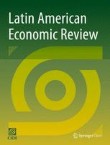
Lo más reciente
How much fiscal space do Latin American countries have to increase their tax burdens in the long term? This paper provides an answer through Laffer curves estimates for taxes on labor, capital, and consumption for the six largest emerging economies of the region: Argentina, Brazil, Chile, Colombia, Mexico, and Peru. Estimates are made using a neoclassical growth model with second-generation human capital and employing data from the national accounts system for the period from 1994 to 2017. Our findings allow us to compare the recent effective tax rates on factor returns against those which would maximize the government's revenues, and therefore to derive the potential tax-related fiscal space. Results suggest that joint fiscal space on labor and capital taxes would reach 6.5% of GDP for the region, on average, and that there are important differences among the countries.

 Fernando Arias-Rodríguez
Fernando Arias-Rodríguez